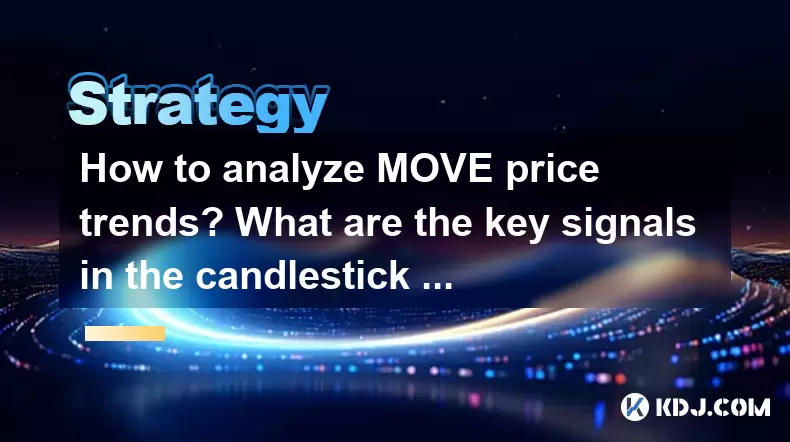-
 bitcoin
bitcoin $124586.364639 USD
0.62% -
 ethereum
ethereum $4670.671710 USD
3.33% -
 xrp
xrp $2.983701 USD
0.18% -
 tether
tether $1.000175 USD
-0.03% -
 bnb
bnb $1209.430642 USD
2.76% -
 solana
solana $231.365861 USD
0.51% -
 usd-coin
usd-coin $0.999665 USD
-0.02% -
 dogecoin
dogecoin $0.264657 USD
4.46% -
 tron
tron $0.346415 USD
1.60% -
 cardano
cardano $0.871586 USD
3.70% -
 chainlink
chainlink $23.451270 USD
7.56% -
 hyperliquid
hyperliquid $46.860071 USD
-2.96% -
 ethena-usde
ethena-usde $1.000120 USD
0.04% -
 sui
sui $3.611279 USD
1.08% -
 stellar
stellar $0.407149 USD
0.96%
How to analyze MOVE price trends? What are the key signals in the candlestick chart?
Analyzing MOVE price trends using candlestick charts and technical indicators like MA, RSI, and MACD helps traders make informed decisions in the crypto market.
May 07, 2025 at 08:29 pm

Analyzing the price trends of MOVE and understanding key signals in candlestick charts are crucial skills for any cryptocurrency trader. This article will delve into the methods and techniques to effectively analyze MOVE price trends and interpret candlestick chart signals to make informed trading decisions.
Understanding MOVE Price Trends
To start analyzing MOVE price trends, it's important to understand the basics of price movement in the cryptocurrency market. MOVE, like other cryptocurrencies, experiences price fluctuations driven by market sentiment, news, and trading volume. To analyze these trends, traders often use technical analysis tools and charts.
One of the primary tools for analyzing price trends is the price chart. By examining historical price data, traders can identify patterns and trends that may indicate future price movements. Common types of charts include line charts, bar charts, and candlestick charts, with the latter being the most popular among traders due to its detailed representation of price action.
Key Components of Candlestick Charts
Candlestick charts are essential for understanding price trends because they provide a visual representation of price movements over a specific time period. Each candlestick consists of four key components: the opening price, the closing price, the highest price, and the lowest price. These components are used to form the body and wicks (or shadows) of the candlestick.
- The body of the candlestick represents the range between the opening and closing prices. If the closing price is higher than the opening price, the body is typically filled or colored (often green or white), indicating a bullish trend. Conversely, if the closing price is lower than the opening price, the body is hollow or a different color (often red or black), indicating a bearish trend.
- The wicks or shadows extend from the top and bottom of the body and represent the highest and lowest prices reached during the time period. Long wicks can indicate strong rejection of certain price levels, while short wicks suggest less volatility.
Identifying Key Signals in Candlestick Charts
Candlestick charts offer several key signals that traders use to predict future price movements. Here are some of the most important signals to look for when analyzing MOVE price trends:
Bullish and Bearish Engulfing Patterns
Bullish engulfing patterns occur when a small bearish candle is followed by a larger bullish candle that completely engulfs the body of the previous candle. This pattern suggests a potential reversal from a bearish to a bullish trend. Conversely, bearish engulfing patterns occur when a small bullish candle is followed by a larger bearish candle, indicating a potential shift from a bullish to a bearish trend.
Hammer and Hanging Man Patterns
The hammer pattern is a bullish reversal signal that forms at the bottom of a downtrend. It is characterized by a small body and a long lower wick, indicating that sellers pushed the price down, but buyers managed to push it back up to near the opening price. The hanging man pattern is similar in appearance but forms at the top of an uptrend, suggesting a potential bearish reversal.
Doji Patterns
Doji patterns occur when the opening and closing prices are very close to each other, resulting in a candlestick with a very small body. A doji indicates indecision in the market and can signal a potential reversal or continuation of the current trend, depending on the context. Variations of the doji include the long-legged doji, dragonfly doji, and gravestone doji, each with its own implications for future price movements.
Using Technical Indicators to Confirm Trends
While candlestick patterns provide valuable insights into price trends, it's beneficial to use technical indicators to confirm these signals. Some of the most commonly used indicators for analyzing MOVE price trends include:
- Moving Averages (MA): These help smooth out price data to identify the direction of the trend. The Simple Moving Average (SMA) and Exponential Moving Average (EMA) are popular choices among traders.
- Relative Strength Index (RSI): This momentum oscillator measures the speed and change of price movements. An RSI above 70 indicates an overbought condition, while an RSI below 30 suggests an oversold condition.
- Moving Average Convergence Divergence (MACD): This trend-following momentum indicator shows the relationship between two moving averages of a security’s price. A bullish crossover occurs when the MACD line crosses above the signal line, while a bearish crossover happens when the MACD line crosses below the signal line.
Practical Steps for Analyzing MOVE Price Trends
To effectively analyze MOVE price trends using candlestick charts and technical indicators, follow these practical steps:
- Select a Reliable Trading Platform: Choose a platform that offers real-time data and charting tools. Popular options include Binance, Coinbase, and TradingView.
- Set Up Your Chart: Open the MOVE price chart and select the candlestick chart view. Adjust the time frame based on your trading strategy (e.g., 1-minute, 1-hour, or daily charts).
- Identify Key Candlestick Patterns: Scan the chart for bullish and bearish engulfing patterns, hammer and hanging man patterns, and doji patterns. Pay attention to the context in which these patterns appear, as they can have different implications depending on the overall trend.
- Apply Technical Indicators: Add moving averages, RSI, and MACD to your chart to confirm the signals provided by candlestick patterns. For example, if you spot a bullish engulfing pattern, check if the RSI is moving out of the oversold territory and if the MACD shows a bullish crossover.
- Monitor Volume: Volume is a critical factor in confirming price trends. An increase in volume during a bullish or bearish pattern can validate the signal, while low volume may indicate a false breakout.
- Backtest Your Strategy: Before applying your analysis to live trading, backtest your strategy using historical data to see how well it performs. This can help you refine your approach and increase your confidence in your trading decisions.
Frequently Asked Questions
Q: How can I differentiate between a bullish and a bearish trend in MOVE price charts?A: To differentiate between a bullish and a bearish trend in MOVE price charts, look at the overall direction of the price movement. A bullish trend is characterized by higher highs and higher lows, indicating that buyers are in control. Conversely, a bearish trend shows lower highs and lower lows, suggesting that sellers are dominating the market. Additionally, use moving averages to confirm the trend: if the price is consistently above a moving average, it's likely in a bullish trend, and if it's below, it's likely in a bearish trend.
Q: What should I do if I spot a doji pattern on the MOVE price chart?A: If you spot a doji pattern on the MOVE price chart, it indicates market indecision. The action you take depends on the context. If the doji forms at the top of an uptrend, it might signal a potential bearish reversal, and you could consider selling or taking profits. If it forms at the bottom of a downtrend, it might suggest a bullish reversal, and you could consider buying or entering a long position. Always confirm the doji pattern with other technical indicators like RSI or MACD before making a trading decision.
Q: How often should I check the MOVE price chart for trend analysis?A: The frequency of checking the MOVE price chart depends on your trading strategy and time frame. For day traders, checking the chart every few minutes or hourly might be necessary to catch short-term trends. Swing traders might check the chart daily or weekly to identify medium-term trends. Long-term investors might only need to review the chart weekly or monthly. It's important to set a schedule that aligns with your trading goals and risk tolerance.
Q: Can I use candlestick patterns alone to make trading decisions on MOVE?A: While candlestick patterns provide valuable insights into price trends, it's not advisable to use them alone for making trading decisions. Candlestick patterns should be confirmed with other technical indicators like moving averages, RSI, and MACD to increase the probability of successful trades. Additionally, consider fundamental analysis and market news to get a comprehensive view of the MOVE market before executing trades.
Disclaimer:info@kdj.com
The information provided is not trading advice. kdj.com does not assume any responsibility for any investments made based on the information provided in this article. Cryptocurrencies are highly volatile and it is highly recommended that you invest with caution after thorough research!
If you believe that the content used on this website infringes your copyright, please contact us immediately (info@kdj.com) and we will delete it promptly.
- BlockDAG, DOGE, HYPE Sponsorship: Crypto Trends Shaping 2025
- 2025-10-01 00:25:13
- Deutsche Börse and Circle: A StableCoin Adoption Powerhouse in Europe
- 2025-10-01 00:25:13
- BlockDAG's Presale Buzz: Is It the Crypto to Watch in October 2025?
- 2025-10-01 00:30:13
- Bitcoin, Crypto, and IQ: When Genius Meets Digital Gold?
- 2025-10-01 00:30:13
- Stablecoins, American Innovation, and Wallet Tokens: The Next Frontier
- 2025-10-01 00:35:12
- NBU, Coins, and Crypto in Ukraine: A New Yorker's Take
- 2025-10-01 00:45:14
Related knowledge

Practical parameter settings for a Bitcoin multi-timeframe moving average system
Sep 18,2025 at 10:54pm
Optimizing Timeframe Combinations for Bitcoin Trading1. Selecting appropriate timeframes is crucial when building a multi-timeframe moving average sys...

How can I filter out false breakouts in Dogecoin high-frequency trading?
Sep 22,2025 at 01:00am
Understanding False Breakouts in Dogecoin Trading1. A false breakout occurs when Dogecoin's price appears to move beyond a defined support or resistan...

Techniques for identifying tops and bottoms in the Bitcoin on-chain NVT model
Sep 20,2025 at 07:54pm
Understanding the NVT Model in Bitcoin Analysis1. The Network Value to Transactions (NVT) ratio is often described as the 'P/E ratio' of the cryptocur...

What does the surge in open interest in Bitcoincoin futures mean?
Sep 20,2025 at 11:18pm
Understanding the Surge in Dogecoin Futures Open Interest1. A surge in open interest within Dogecoin futures indicates a growing number of active cont...

How can I use the Ethereum USDT premium to gauge market sentiment?
Sep 18,2025 at 11:55pm
Understanding the Ethereum USDT Premium1. The Ethereum USDT premium refers to the price difference between USDT (Tether) traded on Ethereum-based plat...

What should I do if Ethereum staking yields decline?
Sep 20,2025 at 06:18am
Understanding the Causes Behind Declining Ethereum Staking Yields1. The Ethereum network transitioned to a proof-of-stake consensus mechanism with the...

Practical parameter settings for a Bitcoin multi-timeframe moving average system
Sep 18,2025 at 10:54pm
Optimizing Timeframe Combinations for Bitcoin Trading1. Selecting appropriate timeframes is crucial when building a multi-timeframe moving average sys...

How can I filter out false breakouts in Dogecoin high-frequency trading?
Sep 22,2025 at 01:00am
Understanding False Breakouts in Dogecoin Trading1. A false breakout occurs when Dogecoin's price appears to move beyond a defined support or resistan...

Techniques for identifying tops and bottoms in the Bitcoin on-chain NVT model
Sep 20,2025 at 07:54pm
Understanding the NVT Model in Bitcoin Analysis1. The Network Value to Transactions (NVT) ratio is often described as the 'P/E ratio' of the cryptocur...

What does the surge in open interest in Bitcoincoin futures mean?
Sep 20,2025 at 11:18pm
Understanding the Surge in Dogecoin Futures Open Interest1. A surge in open interest within Dogecoin futures indicates a growing number of active cont...

How can I use the Ethereum USDT premium to gauge market sentiment?
Sep 18,2025 at 11:55pm
Understanding the Ethereum USDT Premium1. The Ethereum USDT premium refers to the price difference between USDT (Tether) traded on Ethereum-based plat...

What should I do if Ethereum staking yields decline?
Sep 20,2025 at 06:18am
Understanding the Causes Behind Declining Ethereum Staking Yields1. The Ethereum network transitioned to a proof-of-stake consensus mechanism with the...
See all articles










































































